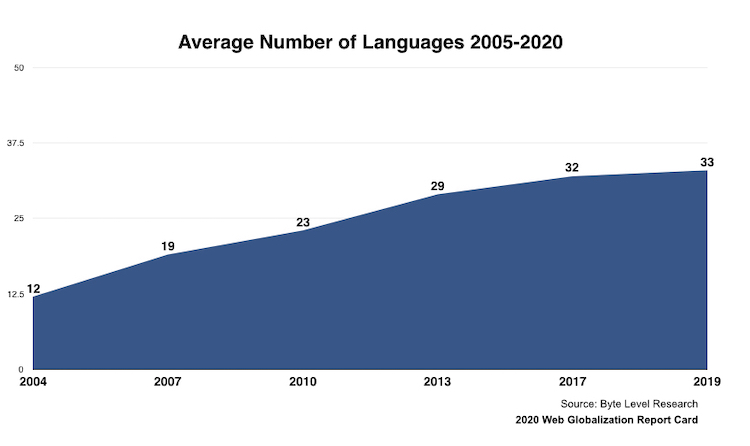I’m now well into research for the 2021 Web Globalization Report Card. And while last year was not a great year for language expansion, there are a surprising number of companies that pushed ahead with linguistic expansion.
As I look to the year ahead, I thought it made sense to revisit a question I’m commonly asked: How many languages should we support?
A little history
Twenty years ago, only a small number of websites supported 10 languages. In fact, it was common to believe that your website was “global” at five or six languages. This was understandable, given that the overwhelming number of Internet users at the time were native-English speakers.
That was then. This is now.
Seen below is a pie chart that represents the 4.5 billion Internet users (as of mid-2020). Fewer than 20% of Internet users are native-English speakers.

To reach the majority of Internet users, you have to cover quite a few languages. And note that large slice that represents “all other languages.”
So how many languages should your website feature to be competitive globally? Before you can answer this, it’s also important to understand how many (and what) languages the leading global brands support.
Learn from the language leaders
Since 2003, I have tracked the languages supported by more than a hundred websites across more than fifteen industry verticals. To ensure that these websites reflect the leading global brands, I include approximately 80% of the Interbrand best global brands (link: http://www.interbrand.com). As shown below, the average number of languages has more than doubled since 2005, from 12 languages to 33.

The average global website now supports 33 languages
A significant number of global brands support well over 33 languages, such as Google, Microsoft, Honda, Uber and IKEA. Just because websites like Microsoft and Coca-Cola support more than 40 languages does not mean that your website should do the same. Every company needs to develop its own unique language strategy.
Factors that companies typically rely upon to help develop language strategies include:
- Country/market expansion goals. Companies rely on a host of indicators (GDP, demographics, political climate, competition) to determine if and when they should expand into new markets. And when a new market is planned, the language(s) spoken within that market should be supported.
- Internet users by language. Because languages are not restricted by borders, sometimes companies take a language-based approach to going global. For example, supporting a Latin American flavor of Spanish could generate significant new website visitors from not only across much of Latin America but also the United States. Spanish is often the first language I recommend that companies add when they have just begun website globalization.
- Languages supported by competitors. Copying the language strategy of a competitor is a simple way to prioritize languages, but it might also leave you blind to market opportunities your competitor has overlooked. Also, if you don’t have a plan for determining “next” languages, you’ll be left playing catch-up with your competitors.
If you want to communicate with the majority of Internet users, plan on supporting 30 or more languages. You may not get there this year or the next, but it’s good to have a realistic goal of what is required to be a truly global company.
Languages are a means to an end. If you want to be sure that you’re not only competing globally but actually leading globally, one thing is certain—the need to support languages.
And lots of them.
